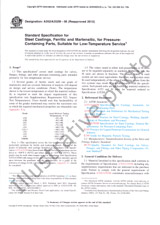We need your consent to use the individual data so that you can see information about your interests, among other things. Click "OK" to give your consent.
ASTM C188-17(2023)
Standard Test Method for Density of Hydraulic Cement
Translate name
STANDARD published on 1.4.2023
The information about the standard:
Designation standards: ASTM C188-17(2023)
Note: WITHDRAWN
Publication date standards: 1.4.2023
SKU: NS-1141592
The number of pages: 3
Approximate weight : 9 g (0.02 lbs)
Country: American technical standard
Category: Technical standards ASTM
The category - similar standards:
Annotation of standard text ASTM C188-17(2023) :
Keywords:
density, hydraulic cement, specific gravity,, ICS Number Code 91.100.10 (Cement. Gypsum. Lime. Mortar)
Additional information
| Significance and Use | ||||||||||
|
4.1?This test method provides a procedure for the determination of density of hydraulic cement samples using non-instrumental techniques. |
||||||||||
| 1. Scope | ||||||||||
|
1.1?This test method covers the determination of the density of hydraulic cement. Its particular usefulness is in connection with the design and control of concrete mixtures. 1.2?The density of hydraulic cement is defined as the mass of a unit volume of the solids. 1.3?The values stated in SI units are to be regarded as standard. No other units of measurement are included in this standard. 1.4?WarningFresh hydraulic cementitious mixtures are caustic and may cause chemical burns to skin and tissue upon prolonged exposure.2 1.5?This standard does not purport to address all of the safety concerns, if any, associated with its use. It is the responsibility of the user of this standard to establish appropriate safety, health, and environmental practices and determine the applicability of regulatory limitations prior to use. 1.6?This international standard was developed in accordance with internationally recognized principles on standardization established in the Decision on Principles for the Development of International Standards, Guides and Recommendations issued by the World Trade Organization Technical Barriers to Trade (TBT) Committee. |
||||||||||
| 2. Referenced Documents | ||||||||||
|
We recommend:
Updating of laws
Do you want to be sure about the validity of used regulations?
We offer you a solution so that you could use valid and updated legislative regulations.
Would you like to get more information? Look at this page.




 Cookies
Cookies
